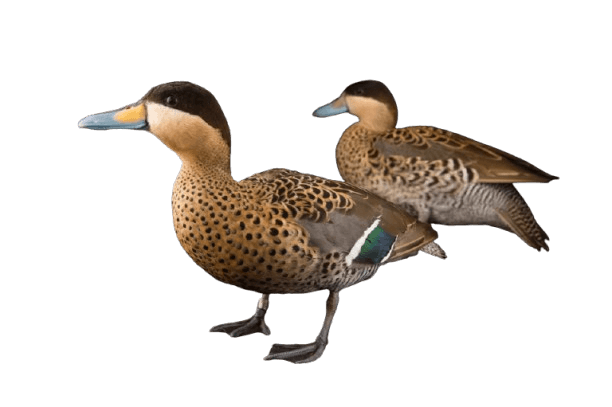Silver Teal

Scientific Name
Spatula versicolor
Alternative Names
Silver Teal, Versicolor Teal
Measurements
| Feature | Male | Female |
|---|---|---|
| Length | 38–45 cm (15–18 in) | 38–45 cm (15–18 in) |
| Wingspan | About 70–75 cm (28–30 in) | About 70–75 cm (28–30 in) |
| Weight | 400–500 g (0.9–1.1 lb) | 350–450 g (0.8–1.0 lb) |
Status
A dabbling duck native to South America. Classified as Least Concern by the IUCN, with stable populations.
Identification
A small duck with a black cap extending down past the eyes, pale face, and finely barred body. The bill is bluish with a yellow tip. Both sexes have a green and blue speculum bordered with white. Females look slightly duller and have less yellow at the base of the bill. They do not have an eclipse plumage, keeping the same appearance year-round.
Voice
Generally quiet and calm. Soft quacks and whistles are used between pairs or family groups.
Diet
Feeds mostly on plant material such as seeds, grasses, and aquatic plants. Occasionally eats small aquatic insects.
Distribution
Found in southern Bolivia, southern Brazil, Paraguay, Argentina, Chile, Uruguay, and the Falkland Islands. Some southern birds migrate to Brazil in winter.
Habitat
Lives in shallow freshwater areas such as marshes, ponds, lakes, and reed-filled wetlands. Prefers calm waters with good plant cover.
Breeding
Nests on the ground, often hidden in thick vegetation or near water. Lays 6–10 creamy eggs between April and June. Incubation lasts about 25–27 days. Both parents care for the ducklings.
Wintering
Southern populations migrate north to milder climates during winter, especially to southern Brazil. Northern groups stay in their range year-round.
Conservation
Not currently threatened. Habitat loss and wetland drainage could affect numbers locally, but overall the species remains stable.
